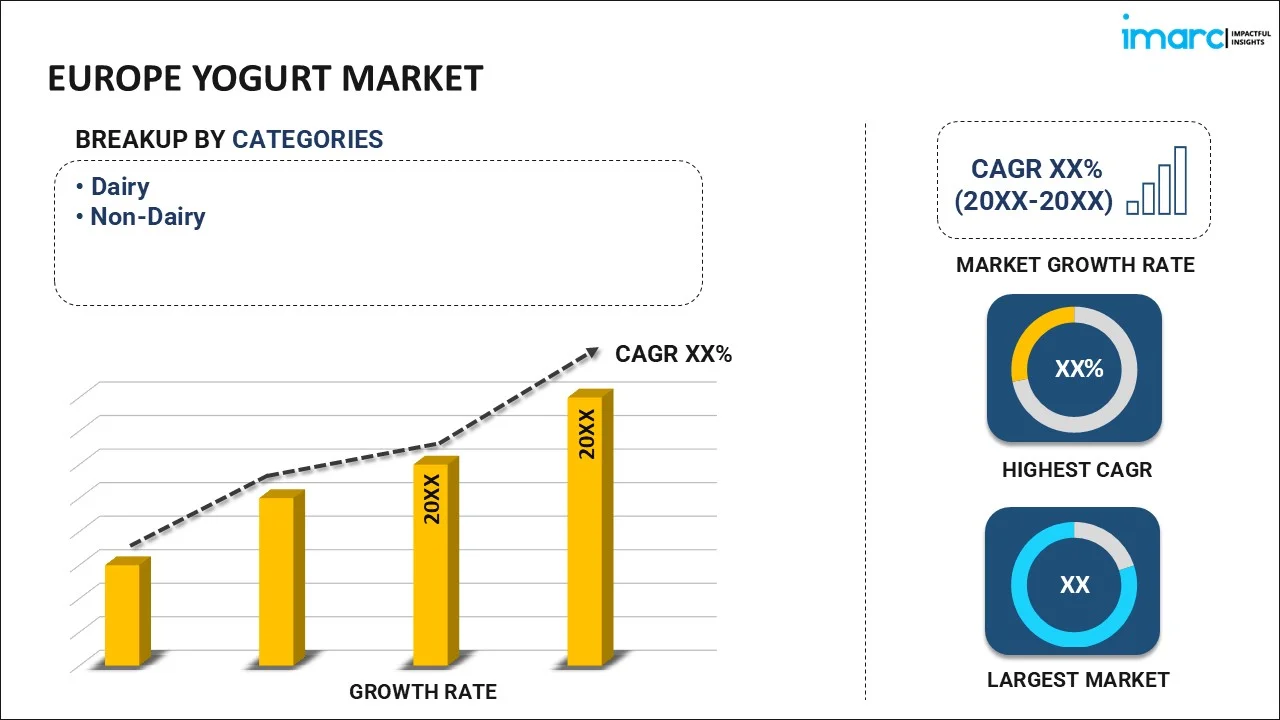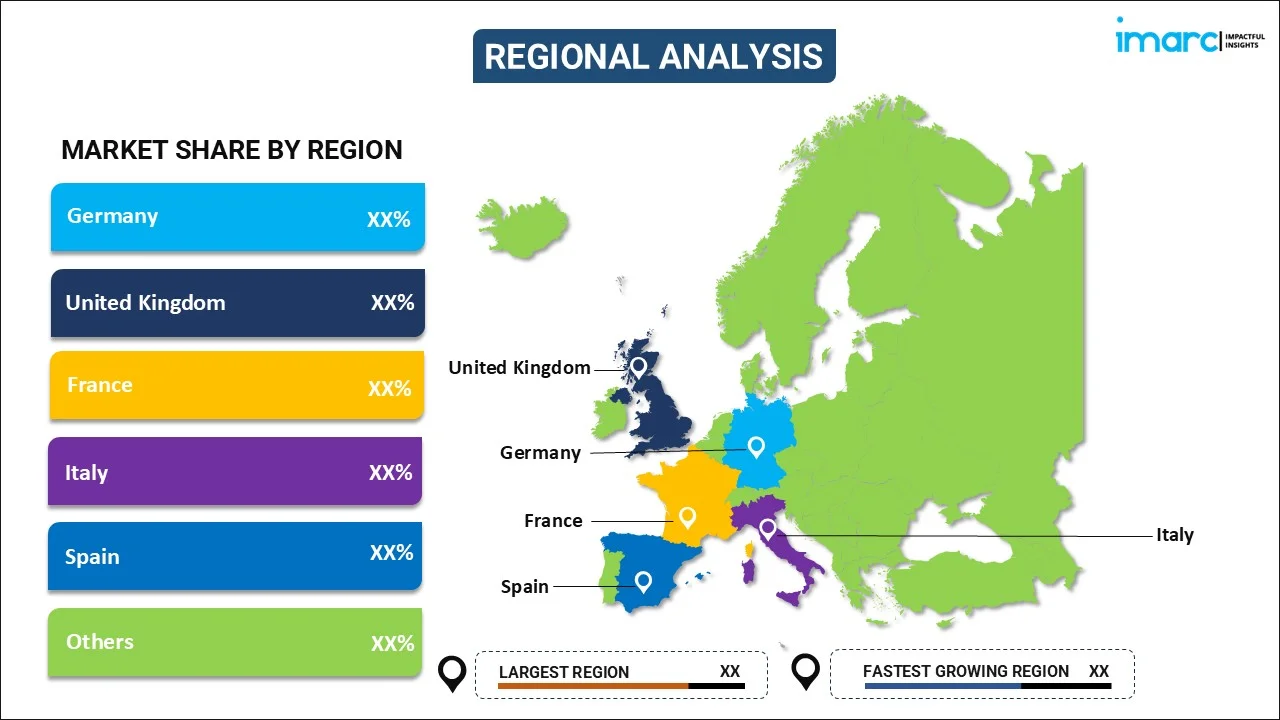
Europe Yogurt Market Size, Share, Trends and Forecast by Category, Type, Distribution Channel, and Region, 2025-2033
Europe Yogurt Market Overview:
The Europe yogurt market size reached USD 32.16 Billion in 2024. Looking forward, IMARC Group expects the market to reach USD 51.19 Billion by 2033, exhibiting a growth rate (CAGR) of 5.30% during 2025-2033. The key drivers in the European yogurt market include increasing consumer demand for plant-based and dairy-free options due to health and sustainability trends. Additionally, functional yogurts enriched with probiotics, protein, and other nutrients are gaining popularity, as is the demand for premium, indulgent, and innovative yogurt varieties catering to diverse preferences.
|
Report Attribute
|
Key Statistics
|
|---|---|
|
Base Year
|
2024 |
|
Forecast Years
|
2025-2033
|
|
Historical Years
|
2019-2024
|
| Market Size in 2024 | USD 32.16 Billion |
| Market Forecast in 2033 | USD 51.19 Billion |
| Market Growth Rate (2025-2033) | 5.30% |
Europe Yogurt Market Trends:
Surge in Plant-Based and Dairy-Free Yogurt Consumption
Plant-based yogurt demand is growing in Europe non-dairy yogurt market as people turn to dairy-free products owing to lactose intolerance, vegan diets, and sustainability issues. Yogurts made from oat, almond, soy, and coconut are becoming popular, with players improving texture and taste to be comparable to dairy products. Growing interest in clean-label foods has seen greater volumes of yogurts being manufactured without artificial additives and preservatives. Besides this, consumer awareness about the environment is also encouraging demand for those brands that embrace sustainable sourcing as well as greener packaging. Along with this, the sales of plant-based yogurt in Europe grew by 16% between 2020 and 2022, while conventional yogurt sales decreased by 4%. Supermarkets as well as special stores are introducing more dairy-free yogurt offerings, further propelling market growth. With ongoing taste and nutritional profiles innovation, plant-based yogurt shall further consolidate itself in the yogurt market in Europe.
Innovation in Functional and High-Protein Yogurts
European consumers are increasingly looking for yogurts that offer added health benefits above and beyond basic nutrition. The trend towards functional yogurts with added probiotics, prebiotics, collagen, and immune-supporting vitamins is growing. Protein yogurts such as Greek and skyr types are still trending among fitness enthusiasts and protein diets. Brands are also launching yogurt products with added fiber and plant proteins to suit various dietary requirements. This innovation in the yogurts is in line with increasing consumer demand for products that promote digestive health, muscle recovery, and overall wellness. With increasing awareness of gut health and immunity, the functional yogurt category is likely to experience steady growth in the European market.
Growth of Premium and Indulgent Yogurt Segments
Premiumization is a driving trend across the yogurt in Europe category, where customers are paying extra for high quality, unusual flavor profiles, and artisanal ingredients. Increased demand for premium, indulgent-style yogurts with exotic fruit, gourmet toppings, and dessert-like flavor profiles is reframing buying behavior. Organic and grass-fed dairy yogurts also remain in high demand on account of their assumed health credentials and ethical origins. Luxury packaging and limited-run flavors are being used to create greater product attractiveness. Premium yogurt brands are also emphasizing sustainability by utilizing environmentally friendly materials and sustainably sourced ingredients. With consumers demanding indulgence as well as quality, the premium yogurt segment is likely to grow, increasing revenue for European manufacturers.
Growing Preference for Portable and Ready-to-Eat Yogurt Options
European consumers are increasingly opting for yogurt formats that fit busy lifestyles. Single-serve packs, squeezable pouches, and drinkable yogurts are becoming popular, especially among working professionals, students, and parents seeking quick, nutritious snacks. These on-the-go options offer convenience without compromising on health benefits, often incorporating high protein, low sugar, or functional ingredients. The portability factor is driving innovation in packaging, with brands introducing resealable, lightweight, and eco-friendly solutions. Refrigerated shelves in retail stores are seeing expanded assortments of grab-and-go yogurt products catering to breakfast skippers and snackers. As time-pressed routines continue to shape eating habits, demand for accessible, easy-to-carry yogurt formats is expected to grow steadily across various age groups and consumer segments in Europe.
Europe Yogurt Market Segmentation:
IMARC Group provides an analysis of the key trends in each segment of the market, along with forecasts at the region level for 2025-2033. Our report has categorized the market based on category, type, and distribution channel.
Category Insights:

To get more information on this market, Request Sample
- Dairy
- Non-Dairy
A detailed breakup and analysis of the market based on the category have also been provided in the report. This includes dairy and non-dairy.
Type Insights:
- Plain Yogurt
- Flavored Yogurt
The report has provided a detailed breakup and analysis of the market based on the type. This includes plain yogurt and flavored yogurt.
Distribution Channel Insights:
- Hypermarkets and Supermarkets
- Convenience Stores
- Online Retail
- Others
A detailed breakup and analysis of the market based on the distribution channel have also been provided in the report. This includes hypermarkets and supermarkets, convenience stores, online retail and others.
Regional Insights:

- Germany
- France
- United Kingdom
- Italy
- Spain
- Others
The report has also provided a comprehensive analysis of all the major regional markets, which include Germany, France, United Kingdom, Italy, Spain and Others.
Competitive Landscape:
The market research report has also provided a comprehensive analysis of the competitive landscape. Competitive analysis such as market structure, key player positioning, top winning strategies, competitive dashboard, and company evaluation quadrant has been covered in the report. Also, detailed profiles of all major companies have been provided.
Europe Yogurt Market News:
- In February 2025, Huhtamaki launched recyclable single-coated paper cups for the Europe yogurt market. These new cups, with under 10% plastic content, are fully recyclable and meet food safety standards. Made in Europe under the ProDairy range, the packaging uses paperboard from renewable wood fibers sourced from sustainably managed forests, offering a lower-polymer alternative to traditional dairy packaging options.
- In November 2024, Lactalis-Nestlé’s joint venture, Lnpf, has launched the "Piacere di Yogurt" line in Italy, marking a strategic entry into the "yogurt gustoso" segment. The creamy yogurts, enriched with milk cream for a velvety texture, are available in four flavors: coconut, vanilla, coffee, and apricot. This launch enhances Lnpf’s portfolio, which already includes popular brands like Sveltesse, Lindahls, and Zymil, showcasing its commitment to innovation and quality in yogurt products.
- In August 2024, The National Dairy Council has launched the EU-funded "Yogurt, Its Great Inside" campaign across Belgium, Ireland, Germany, and Denmark. Promoting yogurt’s health benefits and versatility, the campaign features Dublin cafes Póg and Brother Hubbard, showcasing yogurt in both sweet and savory dishes. The two-week campaign includes outdoor billboards, bus advertisements, print media, and a social media push with influencers, highlighting yogurt’s everyday appeal and culinary potential.
Europe Yogurt Market Report Coverage:
| Report Features | Details |
|---|---|
| Base Year of the Analysis | 2024 |
| Historical Period | 2019-2024 |
| Forecast Period | 2025-2033 |
| Units | Billion USD |
| Scope of the Report |
Exploration of Historical Trends and Market Outlook, Industry Catalysts and Challenges, Segment-Wise Historical and Future Market Assessment:
|
| Categories Covered | Dairy, Nondairy. |
| Types Covered | Plain Yogurt, Flavored Yogurt. |
| Distribution Channels Covered | Hypermarkets And Supermarkets, Convenience Stores, Online Retail, Others. |
| Regions Covered | Germany, France, United Kingdom, Italy, Spain, Others |
| Customization Scope | 10% Free Customization |
| Post-Sale Analyst Support | 10-12 Weeks |
| Delivery Format | PDF and Excel through Email (We can also provide the editable version of the report in PPT/Word format on special request) |
Key Benefits for Stakeholders:
- IMARC’s industry report offers a comprehensive quantitative analysis of various market segments, historical and current market trends, market forecasts, and dynamics of the Europe yogurt market from 2019-2033.
- The research report provides the latest information on the market drivers, challenges, and opportunities in the Europe yogurt market.
- Porter's five forces analysis assist stakeholders in assessing the impact of new entrants, competitive rivalry, supplier power, buyer power, and the threat of substitution. It helps stakeholders to analyze the level of competition within the Europe yogurt industry and its attractiveness.
- Competitive landscape allows stakeholders to understand their competitive environment and provides an insight into the current positions of key players in the market.
Key Questions Answered in This Report
The yogurt market in Europe reached USD 32.16 Billion in 2024.
The Europe yogurt market is projected to exhibit a CAGR of 5.30% during 2025-2033, reaching a value of USD 51.19 Billion by 2033.
The yogurt market in Europe is shifting toward healthier options, with growing demand for plant-based varieties, protein-rich products, and functional benefits like probiotics. Consumers are also favoring clean-label ingredients, low-sugar recipes, and sustainable packaging. Convenience formats like drinkable yogurts are gaining popularity across a broader range of age groups.
Need more help?
- Speak to our experienced analysts for insights on the current market scenarios.
- Include additional segments and countries to customize the report as per your requirement.
- Gain an unparalleled competitive advantage in your domain by understanding how to utilize the report and positively impacting your operations and revenue.
- For further assistance, please connect with our analysts.
 Request Customization
Request Customization
 Speak to an Analyst
Speak to an Analyst
 Request Brochure
Request Brochure
 Inquire Before Buying
Inquire Before Buying




.webp)




.webp)












